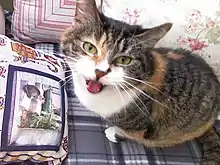Meow
A meow or miaow is a cat vocalization. Meows may have diverse tones in terms of their sound, and what's heard can vary from being chattered to calls, murmurs, and whispers. Adult cats rarely meow to each other. Thus, an adult cat meowing to human beings is generally considered a post-domestication extension of meowing by kittens: a call for attention.[1] Felines usually communicate with each other via their shared sense of smell, yet with people they often make verbal cues around behavior, such as having a specific sound indicate a desire to go outside.[2]

A mew is a high-pitched meow often produced by kittens.[3] It is apparently used to solicit attention from the kitten's mother,[4] and adult cats may use it as well.[3] The mew is similar to what is described in Brown et al. 1978 as an isolation call. By around three to four weeks of age kittens do not mew when at least one littermate is present, and at four to five months of age kittens stop mewing altogether.[5]
Background and biological details
A cat's meow can be assertive, plaintive, friendly, bold, welcoming, attention-soliciting, demanding, or complaining. It can even be silent, where the cat opens its mouth but does not vocalize.[6] Just as humans may verbalize exhaustively when they are happy, so can cats. According to The Purrington Post, a chatty cat is likely happy too.[7]
Meowing fundamentally evolves as a learned behavior. Once-feral cats do so much more rarely than felines accustomed to human interaction their entire lives. Particularly attached cats will meow in an imitative and reflective fashion in response to human communication that involves a back-and-forth process between the two beings, which can involve mutual emotional connection.[2]
Etymology
In American English, the spelling "meow" was first used in 1842. Before that, the word could be spelled "miaow", "miau", or "meaw". Of any variant, the earliest attestation of a cat's cry in Early Modern English is from the 1630s.[8]
See also
References
- "Meowing and Yowling". Virtual Pet Behaviorist. ASPCA. Archived from the original on 6 September 2012. Retrieved 28 May 2012.
- Whitcomb, Isobel (September 15, 2022). "Why do cats meow". Live Science. Archived from the original on June 10, 2023. Retrieved June 10, 2023.
- Schötz, Susanne; van de Weijer, Joost; Eklund, Robert (25 August 2017). Phonetic Characteristics of Domestic Cat Vocalisations (PDF). 1st Intl. Workshop on Vocal interactivity in-and-between Humans, Animals and Robots (PDF). pp. 5–6. ISBN 978-2-9562029-0-5.
- Miller, P. (2000). "Whisker whispers". Association of Animal Behavior Professionals. Archived from the original on 5 November 2013. Retrieved 5 November 2013.
- Brown, K.A.; Buchwald, J.S.; Johnson, J.R.; Mikolich, D.J. (1978). "Vocalization in the cat and kitten". Developmental Psychobiology. 11 (6): 559–570. doi:10.1002/dev.420110605. PMID 720761.
- Bradshaw, John W. S. (January 2016). "Sociality in cats: A comparative review". Journal of Veterinary Behavior: Clinical Applications and Research. 11: 113–124. doi:10.1016/j.jveb.2015.09.004. ISSN 1558-7878.
- Romper, 1 June 2018 - Do Cats Smile? Here's How To Tell Your Cat Is Happy, At Least On The Inside By Shari Maurer Archived 2020-11-11 at the Wayback Machine
- "Meow". Online Etymology Dictionary. Archived from the original on 18 October 2017. Retrieved 27 December 2015.